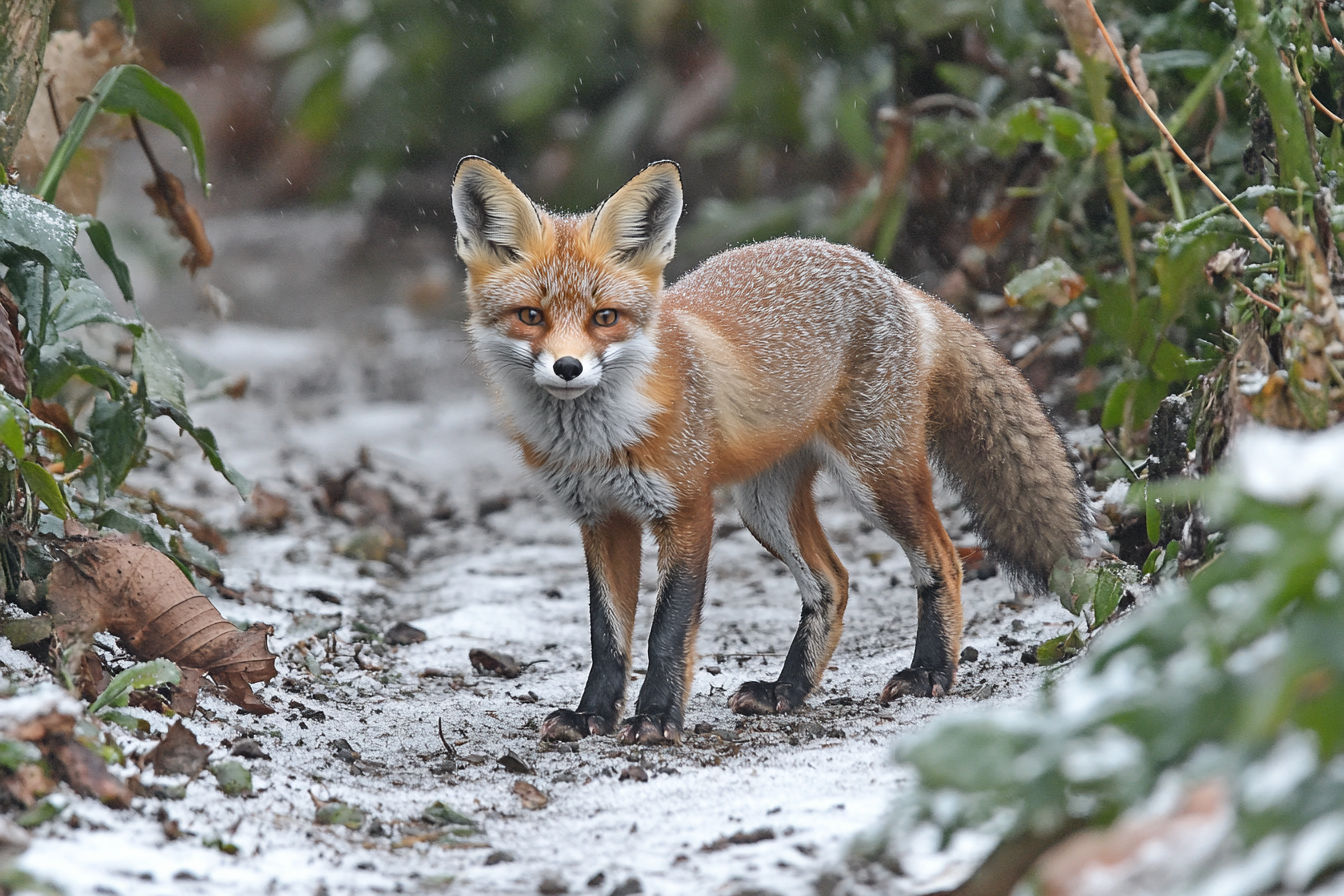Why Do Foxes Disappear? The Guide to Their Secret Lives in Britain
Ever wondered why foxes disappear? Discover the secrets behind their sudden absence and the behaviors that drive it.

This post may contain affiliate links. If you make a purchase through these links, we may earn a commission at no additional cost to you.
It’s a familiar scene for millions of us across the UK. You’re washing up after dinner, gazing out at the garden as the evening light fades to a deep blue. And then, a flicker of movement. A flash of russet fur, a sharp, intelligent face, and a magnificent bushy tail. A fox, picking its way silently across your lawn. You watch, captivated, for a minute or two. Then, as quickly as it appeared, it melts into the shadows of the Leylandii hedge and is gone.
You might see this same fox every night for weeks. You might even give it a name. But then one day, it’s not there. The following night, still no sign. A week goes by, and your garden feels strangely empty. You’re left wondering: why do foxes disappear?
It’s a question with no single answer. The disappearance can be temporary or permanent, natural or tragic. It’s a mystery tied to a complex web of seasonal rhythms, daily routines, intricate social lives, and the ever-present challenges of surviving in modern Britain. To understand why our fiery neighbours vanish, we need to step into their world and learn to think like a fox. This is the ultimate guide to their secret lives.
The Fox’s Year: A Seasonal Timetable of Disappearance
A fox’s life is governed by the seasons. Their behaviour, and therefore their visibility to us, changes dramatically throughout the year. What seems like a sudden disappearance is often just the next chapter in their annual cycle.
Winter (December – February): The Season of Love and Scarcity
Winter is a tough time for foxes. Food is harder to find, the nights are long and cold, and energy is precious. But it’s also the peak of their social calendar: mating season.
During these months, you’re more likely to hear a fox than see one. The nights are filled with their eerie, hair-raising screams. That blood-curdling shriek you hear at 2 a.m. isn’t a sign of distress; it’s the vixen’s (female fox) piercing call to advertise her availability to potential mates. The dog foxes (males) will respond with a triple-bark reply.
- Why they might ‘disappear’: While they are more vocal, dog foxes will travel far and wide outside their usual territories in search of a mate. A fox that was a regular visitor might leave its patch for days or weeks on this quest. Their focus is singular, and your garden may no longer be on their route. They become nomads, driven by instinct.
Spring (March – May): A Secretive Family Life Begins
After a gestation period of around 53 days, the vixen gives birth to a litter of cubs, typically in March or April. This is a time of intense secrecy and is one of the most common reasons for a vixen to completely vanish.
She will have prepared a den, known as an ‘earth’, well in advance. This could be a complex tunnel system dug into a railway embankment, a space under a garden shed, or a hollow beneath tree roots. For the first few weeks of their lives, the cubs are blind, deaf, and utterly dependent on their mother.
- Why they might ‘disappear’: The vixen will rarely leave the den for the first month. Her entire world shrinks to the dark, warm space where she is nursing her young. The dog fox and sometimes other subordinate vixens from the previous year’s litter will act as providers, bringing food to the den for her. You won’t see her because she is in a self-imposed lockdown. Her disappearance is a sign of new life.
Summer (June – August): School’s Out for Young Foxes
As the cubs grow, they’ll start to emerge from the den, usually around late April or May. By summer, your garden might suddenly transform from a quiet patch of green into a chaotic playground. You may go from seeing one or two adult foxes to a whole family of five or six tumbling, playing, and pouncing on everything that moves.
This is the time of learning. The cubs, now looking like lanky, miniature versions of their parents, are taught how to hunt and forage. The adults will bring them live prey, like mice or young rats, to help them practise their skills.
- Why they might ‘disappear’ (or appear!): This is a period of maximum visibility. However, the family may have several dens and can move the cubs at a moment’s notice if they feel the current location is disturbed or unsafe. So, a garden full of fox cubs one day might be completely empty the next, as the vixen has simply relocated them to a safer spot under the neighbour’s decking.
Autumn (September – November): The Great Dispersal
Autumn is the season of the most profound and permanent disappearance. The cubs are now fully grown and physically indistinguishable from the adults. The family unit that was so tight-knit during the summer begins to break down. This is the time of dispersal.
To prevent overcrowding and inbreeding, the young foxes are forced to leave the family territory and find a patch of their own. It’s a daunting and perilous journey. These young, inexperienced foxes must navigate busy roads, cross rival territories, and learn to fend for themselves entirely.
- Why they might ‘disappear’: This is nature’s way. The playful cubs you’ve watched grow up all summer have to leave. The dominant cubs, often the males, are typically the first to be pushed out. They can travel dozens, sometimes hundreds, of miles in search of a vacant territory. The family you knew is disbanded, and your garden population will shrink back to the original adult pair, or perhaps just one of them. This annual exodus is the single biggest reason a familiar group of foxes vanishes.
A Day in the Life: Where Do Foxes Go When the Sun is Up?
Foxes are primarily nocturnal or, more accurately, crepuscular—meaning they are most active at dawn and dusk. Their vanishing act isn’t just seasonal; it’s a daily occurrence. So, where do they go when the morning traffic starts and the world wakes up?
The Importance of the Den or ‘Earth’
While dens are essential for raising cubs, they are used year-round as safe places to sleep and shelter from bad weather or threats. A fox’s territory will contain a main earth and several smaller, less-used ones. These provide escape routes and alternative places to rest. A rural fox might dig its earth into a hillside, while an urban fox gets more creative.
Urban Hideouts: A Fox’s Guide to Your Garden
Our towns and cities are a paradise of hiding spots for a clever fox. They have adapted brilliantly to the urban landscape. Their favourite daytime snoozing spots include:
- Underneath garden sheds or decking: This is prime real-estate. It’s dry, secure, and dark—the perfect man-made den.
- In overgrown bramble patches or thickets: These provide excellent, impenetrable cover.
- On a shed roof or garage: A warm, flat roof can be an ideal sunbathing spot, surprisingly out of sight from the ground.
- Within allotments, railway embankments, and cemeteries: These areas often have less human traffic during the day and plenty of cover.
A fox can make itself incredibly small and can squeeze into surprisingly tight gaps. The reason you don’t see them is because they have spent hours finding the perfect spot to remain undisturbed.
Why the Secrecy? Survival in a Human-Dominated World
This daily disappearance is a simple survival strategy. Although foxes have become bolder in urban areas, their instinct is to avoid their main potential threat: humans and their dogs. By lying low during our busiest hours, they minimise the risk of confrontation. They wait for the cloak of twilight to provide them with the confidence to emerge and begin their nightly patrols.
The Social Ladder: Understanding Fox Territories and Family
A fox’s decision to stay or go is also deeply rooted in its social life. They are not the solitary creatures many people believe them to be.
Are Foxes Lone Wolves?
Not at all. The typical social group consists of a breeding pair (a dog fox and a vixen) and their cubs from the current year. Sometimes, the group might also include a subordinate female from a previous litter who acts as a ‘helper’ in raising the new cubs. It’s a small family unit, not a pack.
The Scent-Based Postcode System
Foxes are highly territorial. They mark the boundaries of their patch with urine and faeces, creating a ‘scent map’ that communicates ownership to rivals. A fox that strays into another’s territory risks a violent confrontation. This rigid system keeps fox populations spread out.
The size of a territory depends on the richness of the resources. In a typical British city, with its abundance of discarded food, overflowing bins, and residents who leave out food, a territory can be as small as 25 hectares (about 60 acres). In the sparse Scottish Highlands, a fox territory can be up to 4,000 hectares.
When It’s Time to Leave the Nest
As we saw with autumn dispersal, this territorial nature is why most young foxes must disappear. There simply isn’t enough room or food for them to stay once they mature. The parents, particularly the vixen, will begin to show aggression towards their own children, chasing them away to ensure the territory can support the core family unit through the coming winter. It seems cruel, but it’s essential for the survival of the species.
Town Mouse, Country Mouse: The Urban vs. Rural Fox Divide
While they are the same species (Vulpes vulpes), the pressures on urban and rural foxes are different, which can affect why they might disappear.
The City Slicker’s Diet
Urban foxes have a famously varied diet. They are expert foragers, and studies have shown that a large portion of their food comes from what we leave behind. This includes scavenging from bins, eating discarded takeaways, and taking food left out for other animals (or for them). They will also eat natural prey like rats, mice, pigeons, and insects, as well as berries and fruit. This reliable food supply means urban territories can be smaller and support a higher density of foxes.
Territories in Town and Country
A rural fox relies almost entirely on hunting. Its diet consists of rabbits, field voles, birds, and insects. This food source is less reliable and more spread out, meaning a country fox needs a much larger territory to survive. A rural fox might ‘disappear’ for longer periods simply because it has to cover a much greater distance on its nightly hunt.
The Final Disappearance: Threats Facing Britain’s Foxes
Sadly, sometimes when a fox disappears, it is for good. The average lifespan of an urban fox is short, typically only 18 months to two years, though they can live much longer. There are many dangers they face.
The Biggest Killer: Cars and Roads
Without a doubt, the single greatest threat to a fox in the UK is the motor vehicle. It’s estimated that around 100,000 foxes are killed on British roads every year. Young, dispersing foxes in the autumn are particularly vulnerable as they attempt to cross unfamiliar and dangerous motorways and A-roads. For many, their first journey away from home is their last.
Sickness and Disease: Nature’s Cruel Hand
Foxes are susceptible to a range of diseases and parasites. The most well-known is Sarcoptic Mange. This is a skin condition caused by a mite that burrows under the skin. It causes intense irritation, leading to hair loss, crusty sores, and eventually, if left untreated, a slow, painful death from hypothermia or infection. A fox suffering from mange will look thin and ragged. It may become unusually bold, seeking warmth and food in the daytime, before eventually disappearing to die in a secluded spot.
Human Conflict and Control
Though the controversial practice of hunting foxes with packs of hounds was banned in England and Wales in 2004, foxes are still subject to ‘pest control’ in some circumstances. They can be legally trapped or shot. While this is less common in urban gardens, it can be a reason for their disappearance, particularly on the fringes of towns or in rural areas.
Fox Fact from Fiction: Debunking Common Myths
Our understanding of foxes is often clouded by myths. Let’s set the record straight on a few common ones related to their presence and absence.
Myth 1: Foxes Hibernate in Winter
This is completely untrue. As we’ve seen, winter is one of their busiest and most important seasons for socialising and mating. They remain active throughout the coldest months, their thick winter coat providing all the insulation they need.
Myth 2: Urban Foxes are a Different Species
Nope. They are exactly the same species as their country cousins. Urban foxes are simply rural foxes that, over the last century, adapted their behaviour to exploit the opportunities our towns and cities provide. They tend to be bolder and live in denser populations, but they are genetically the same animal.
Myth 3: A Fox is a Major Danger to Your Cat or Dog
Confrontations are rare, and usually, it’s the fox that comes off worse. A fox is a strategist; it weighs up risk and reward. An adult cat is a well-armed opponent with sharp claws, and a dog represents a major threat. A fox will almost always choose to flee rather than fight. The vast majority of cats and foxes coexist, ignoring each other or maintaining a respectful distance. Small pets like guinea pigs or rabbits, however, are a different matter and should always be housed securely.
Living Harmoniously: A Practical Guide for Fox-Aware Britons
Understanding our wild neighbours is the first step to coexisting with them. Here’s some practical advice.
To Feed or Not to Feed?
This is a hotly debated topic. While leaving out food can offer a lifeline, especially for a sick or struggling fox, it can also cause problems.
- Artificial high populations: Regular feeding can lead to a territory supporting more foxes than it naturally would, which can increase the spread of disease like mange.
- Habituation: It can make foxes lose their natural fear of humans, which could put them in danger.
- Neighbour disputes: Not everyone loves foxes, and leaving out food can attract them to areas where they are not welcome. If you choose to feed them, offer small amounts of lean meat, cooked potatoes, or a little cheese. Never leave out large quantities and don’t try to hand-feed them.
What to Do If You Find an Injured Fox
If you see a fox that is clearly injured (e.g., with a broken leg) or appears very sick and lethargic, the best thing to do is contact a wildlife rescue organisation. The RSPCA, your local vet, or a dedicated organisation like The Fox Project can offer advice and assistance. Don’t try to approach or handle the fox yourself; it will be scared and may bite in self-defence.
Creating a Fox-Friendly (or Fox-Proof) Garden
- Fox-Friendly: Leave a wild corner of your garden to grow, provide a source of fresh water, and ensure there are no hazards like uncovered drains or tangled netting.
- Fox-Proof: Use secure fencing (they are excellent climbers and diggers), keep bins securely lidded, and use scent-based deterrents. The key is to make your garden less appealing than your neighbour’s.
Conclusion: Appreciating Our Elusive Neighbour
So, why do foxes disappear?
They disappear daily, into the quiet, hidden corners of our world to wait for us to go to bed. They disappear seasonally, as vixens retreat to raise their young in secret, and as a new generation of adventurers sets off into the unknown. And sometimes, they disappear permanently, victims of the roads, of disease, or of conflict.
The fox is the ultimate survivor. It is a creature of immense intelligence and adaptability, a wild spirit that has learned to navigate the concrete and tarmac of our modern world. Their disappearances are not a magic trick, but a reflection of a life lived in the margins, governed by ancient rhythms and modern dangers. The next time a fox vanishes from your garden, you’ll know it’s not just an ending, but often the start of a new, secret chapter in its remarkable life.
Further Reading
For those interested in learning more about the behaviour and welfare of British foxes, these resources are highly recommended:
- The Wildlife Trusts: A nationwide organisation with extensive information on British wildlife, including the Red Fox.
- The RSPCA (Royal Society for the Prevention of Cruelty to Animals): Provides guidance on living with foxes and what to do if you find a sick or injured animal.
- The Fox Project: A dedicated charity offering ambulance services, wildlife hospitals, and advice specifically for foxes.
- The Mammal Society: A scientific society providing authoritative information on British mammals.






